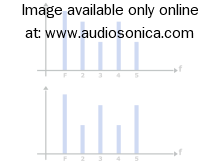Total Harmonic Distortion
This quantity measures the addition of a noise by a device to an audio signal passing through it. This mainly occurs because the exact rate of the input signal is not precisely reproduced: the device modifies the signal's slope (mainly by introducing saturation) and thus modifies its frequency content. This generates new frequencies which were not present in the initial signal, and which are therefore considered as noise. THD, achronim of Total Harmonic Distortion, is the quantity to employ when evaluating the quality of a device which should theoretically have at the output the same frequency content sent through the input.
Let's now refer to an audio signal consisting in one single frequency, an example we can easily extend to complex signals. The harmonic distortion of a device is calculated by using the following procedure. A signal composed of a single 1 KHz reference frequency with a fixed amplitude is sent to the device's input and its corresponding output signal is measured. This returns the 1 KHz frequency at the output (which could be amplified or attenuated) plus a set of harmonics with a far lower amplitude than the initial frequency, but which are the very cause of the distortion we are dealing with. The amplitude decreases as harmonics increase, and indeed already after the third harmonic, it no longer becomes worthy of note. The measuring unit for harmonic distortion is then called THD and is calculated with the following formula:
Let's take a concrete, tangible example. Suppose we were to find a signal with the following frequency content at the device's output:
Let's suppose that the harmonics' amplitudes in relation to the fundamental are:
Second harmonic: 0.01%
Third harmonic: 0.02%
Fourth harmonic: 0.005%
So the Total Harmonic Distortion will be:
Normally the fundamental's amplitude is indicated in the device's specification sheet. If this isn't the case, take 0 Vu to be your amplitude. THD values that exceed 3% are considered to be absolutely unacceptable.
Often the THD value is expressed in dB using the following formulae:
If we consider a THD = 3% (borderline case), we'd calculate the dB value and get -30 dB as our result; this means that the total harmonic distortion has an amplitude that is 30 dB lower than the fundamental. A 30 dB difference is considerably audible. This is the reason why such distortion levels are considered unacceptable.
Example 16.1. Exercise:
let's take two amplifiers whose specific characteristics are as follows:
At the fundamental frequency 1 KHz, 0 Vu on the first amplifier we measured: THD = 0.01 %
At the fundamental frequency 1 KHz, 0 Vu on the second amplifier we measured: THDdB= 70 dB
Which of these two amplifiers is better?
By making a few calculations we'd find that the first is better than the second.
Tip
Convert one of the two THDs into the other's measuring unit, using the aforementioned conversion formulae.
Sometimes the THD values of the single harmonics are given in the specifications sheet. For example:
Second harmonic = -70dB
Third harmonic = -80dB
Fourth harmonic = -90dB
In this case to calculate the overall THD we can use the formula for summing up dBs:
Equation 16.3. THD calculation
Another important aspect of the THD becomes evident when you compare the following figures:
In this case the two devices have the same THD value, but the first is better anyway. This is because for the first device (first graph) the second harmonic is the highest, namely it is an octave above the fundamental and therefore effectively the same note. In the second device (second graph) the third harmonic has the highest amplitude and will be clearly discernible because it is a different note to the fundamental.
The THD value of a piece of equipment is always written on the data specifications sheet supplied by the constructors which contains the technical specifications of the device. The THD quantities vary according to the equipment's work-context. For example we can expect a THD value of around 0.01% from a 10 W amplifier, whereas for a 200 W amplifier we'd be looking at a THD of about 0.1%. This is because as we increase the power of the signal we wish to manipulate, the precision of the electronic component in question decreases (power and precision are antithetical characteristics). In the world of digital technology we can rely on positively lower THD values. The stated THD value of a ProTools system in its standard configuration is 0.004%.
So there you have it, we have looked at the main sources of noise and we have found a unit for measuring noise due to harmonic distortion. Now it's time to walk on the bright side of the road (a rather noisy road it is too!) and discover how to act on the signal to reduce noise with more or less sophisticated techniques.


Spectrum of an amplified signal where distortion has been added